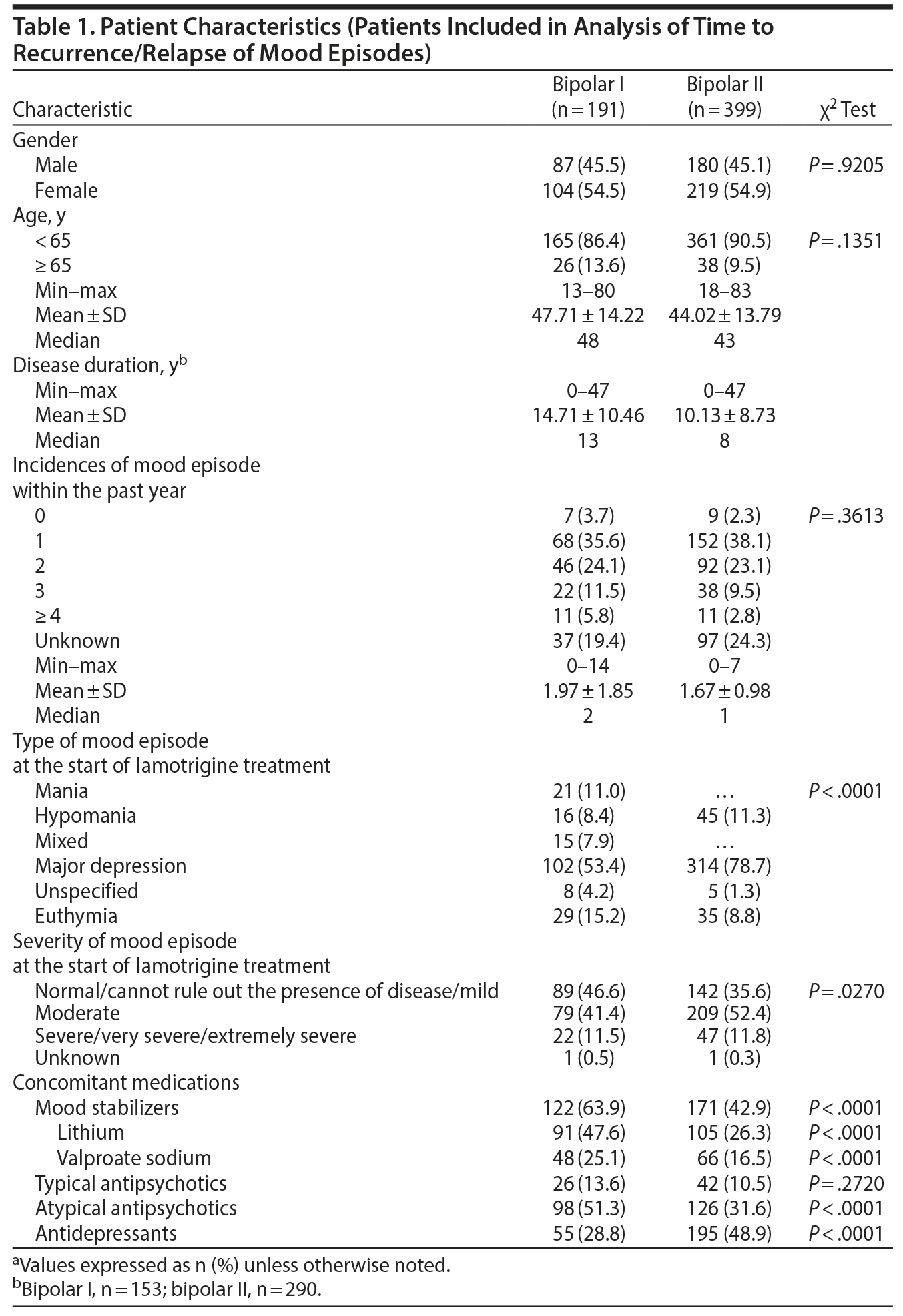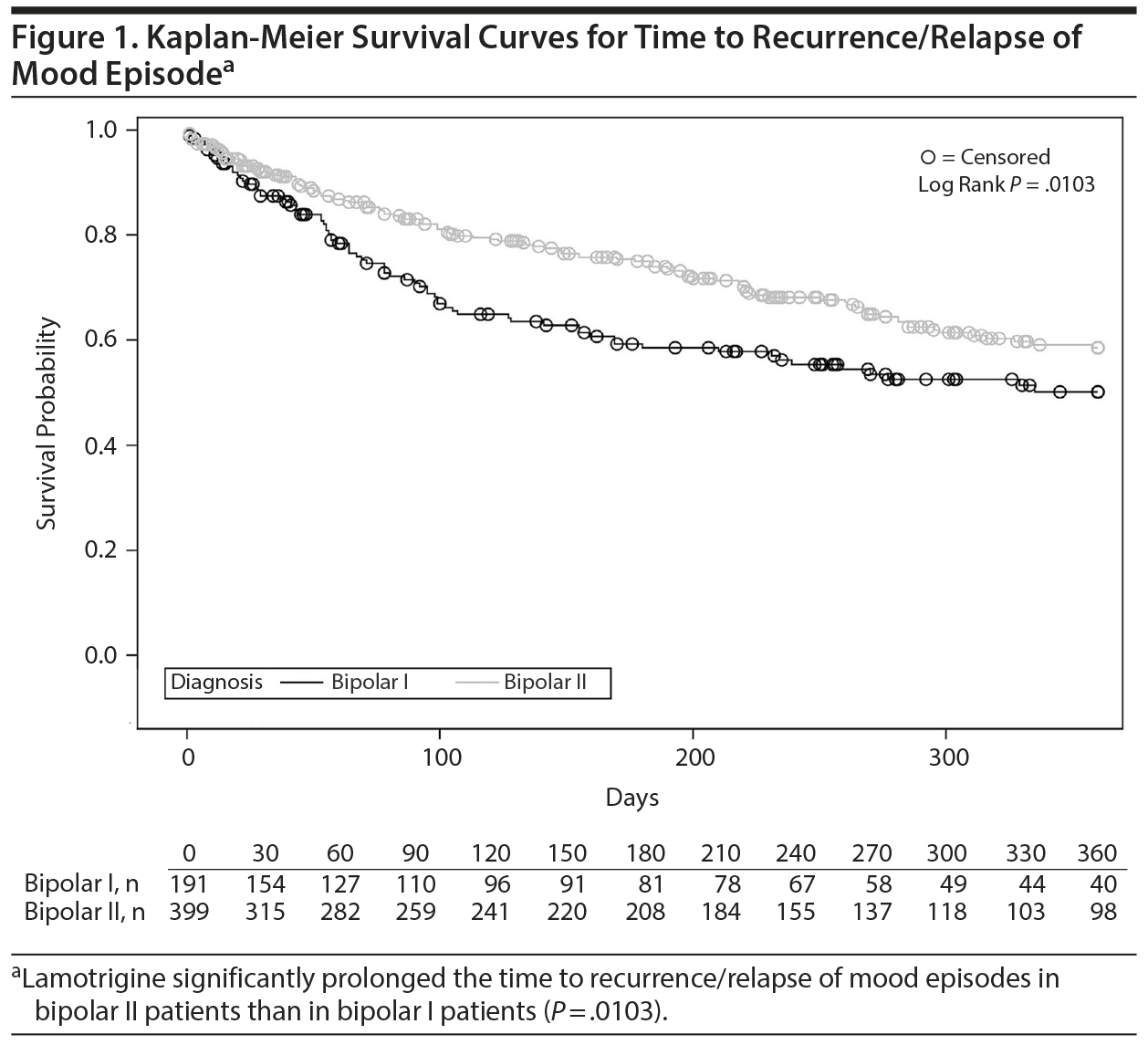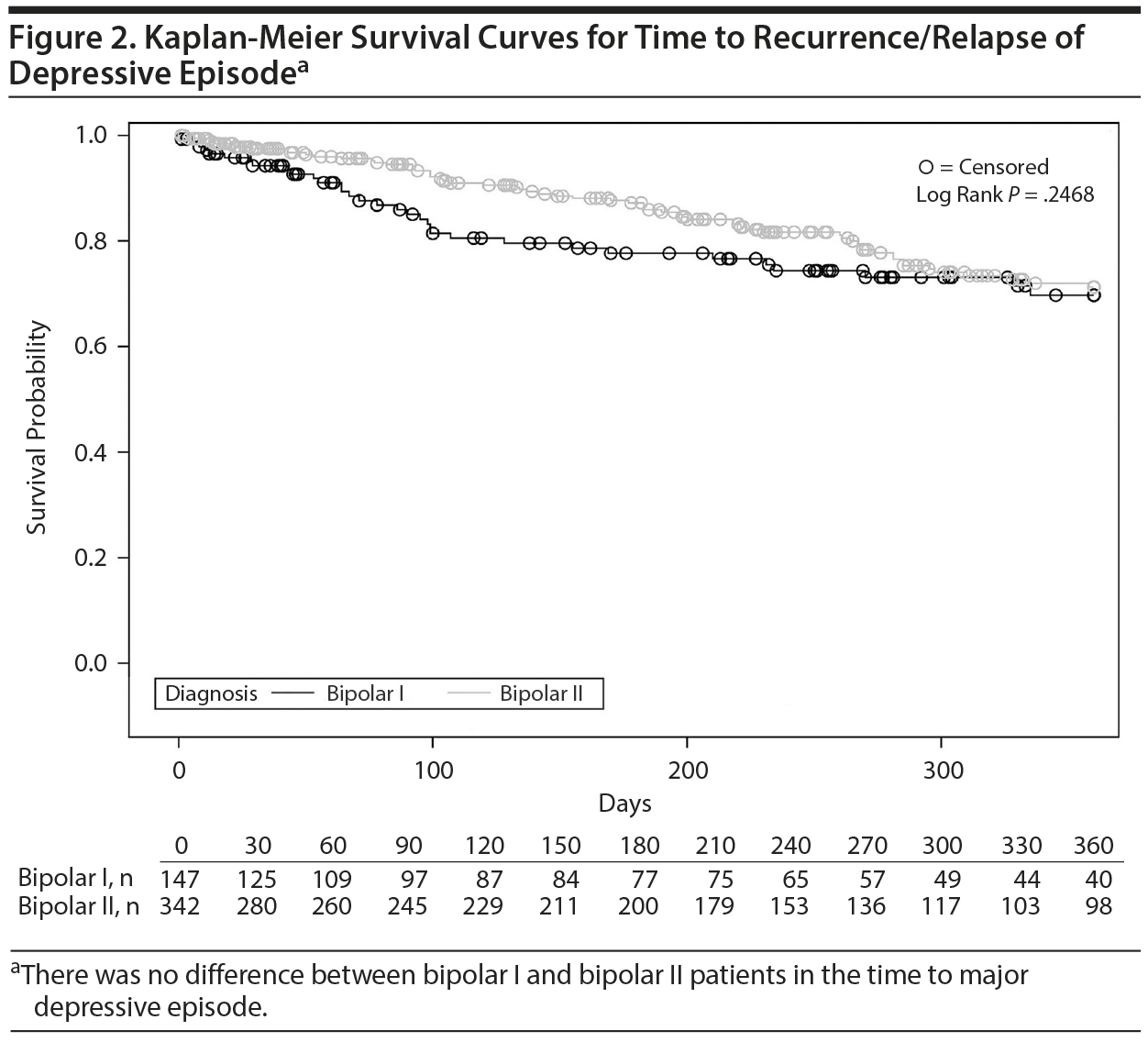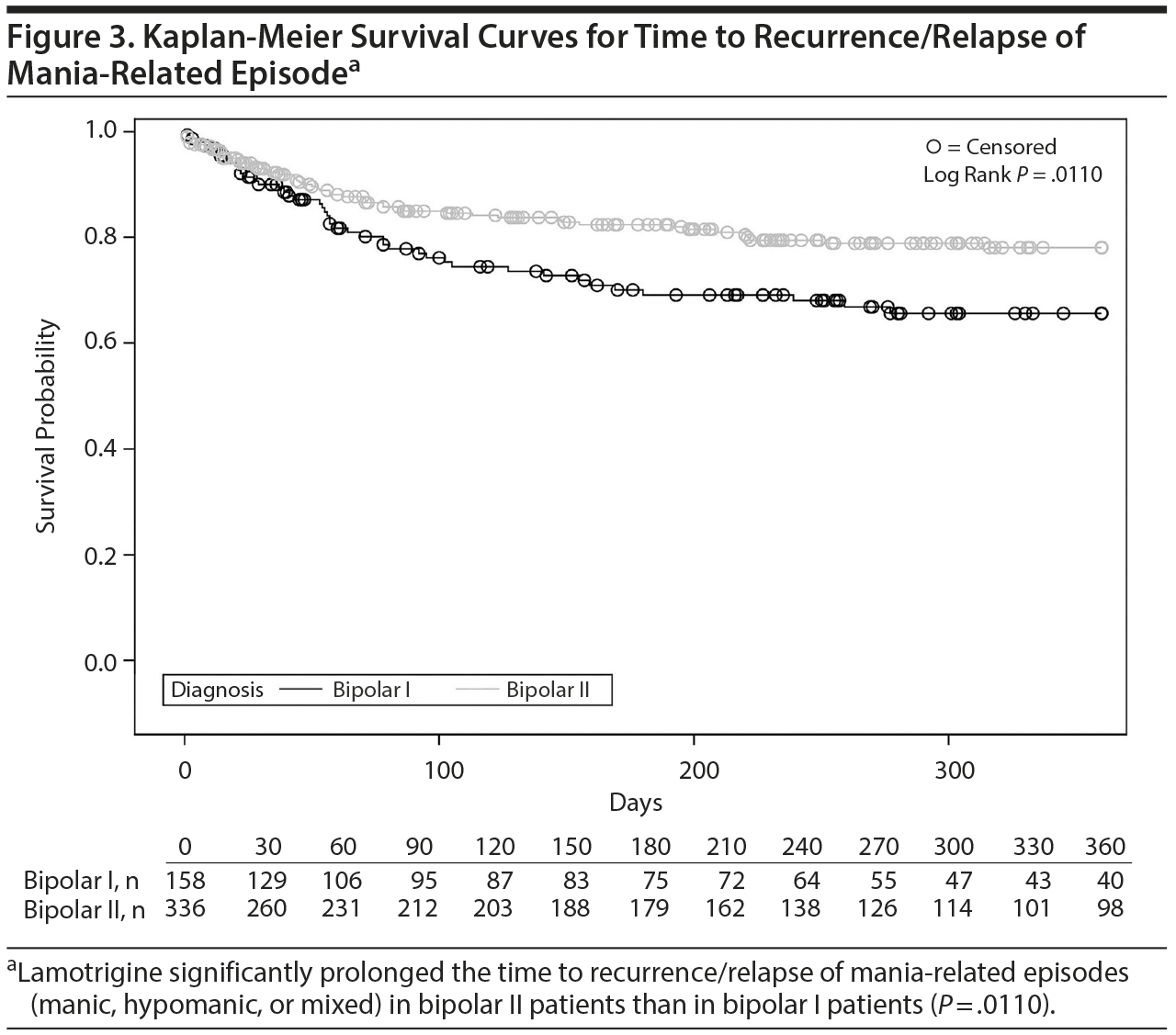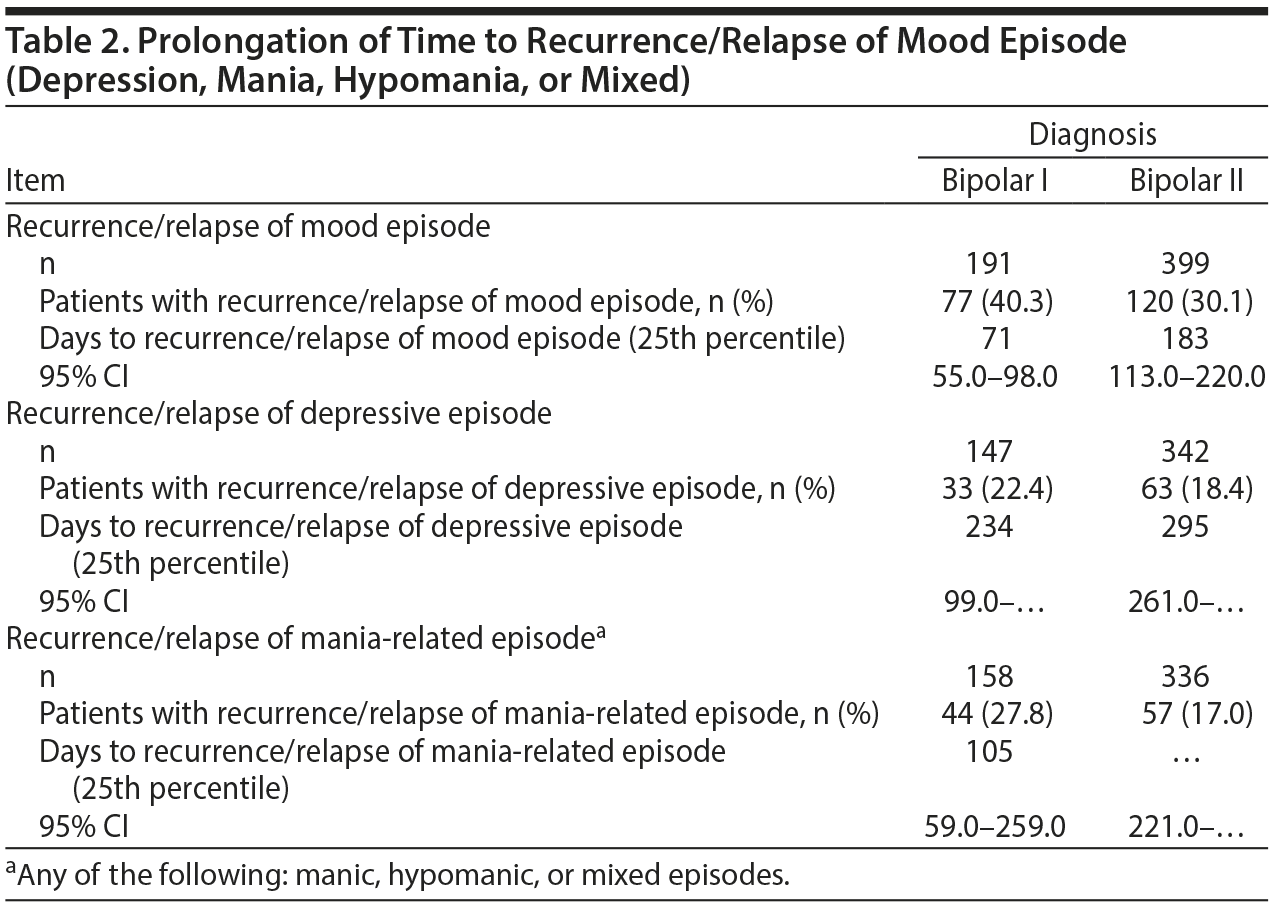Objective: The preventive effects of mood stabilizers on recurrence/relapse in bipolar disorders have been investigated mostly in bipolar I disorder (BPI) patients, with limited reports on bipolar II disorder (BPII) patients. Here, we conducted an explorative data analysis to investigate whether the preventive effect of lamotrigine on recurrence /relapse in BPII is better than in BPI.
Methods: Data from Japanese patients with a diagnosis of BPI or BPII according to DSM-IV-TR were analyzed in an open-label, noninterventional, naturalistic, prospective postmarketing surveillance study of lamotrigine. This study was carried out from October 2011 to November 2014, and each patient was observed for 1 year. The time to recurrence/relapse of mood episodes after commencement of lamotrigine treatment was evaluated as a primary endpoint. Kaplan-Meier curves were generated to compare the time to recurrence/relapse of mood episodes in BPI with in BPII using a log-rank test.
Results: Lamotrigine was associated with a significantly longer time to recurrence/relapse of mood episodes in BPII than in BPI (log-rank test, P = .0103). Lamotrigine also prolonged time to recurrence/relapse of mania-related episodes, including hypomanic episodes, more in BPII than in BPI (P = .0110).
Conclusions: Although the preventive effect of lamotrigine on recurrence/relapse of mood episodes in BPI has been established in a variety of clinical studies, the present study suggests that lamotrigine may be more suitable for maintenance treatment in BPII than in BPI.
This work may not be copied, distributed, displayed, published, reproduced, transmitted, modified, posted, sold, licensed, or used for commercial purposes. By downloading this file, you are agreeing to the publisher’s Terms & Conditions.
Preventive Effects of Lamotrigine in Bipolar II Versus Bipolar I Disorder

ABSTRACT
Objective: The preventive effects of mood stabilizers on recurrence/relapse in bipolar disorders have been investigated mostly in bipolar I disorder (BPI) patients, with limited reports on bipolar II disorder (BPII) patients. Here, we conducted an explorative data analysis to investigate whether the preventive effect of lamotrigine on recurrence /relapse in BPII is better than in BPI.
Methods: Data from Japanese patients with a diagnosis of BPI or BPII according to DSM-IV-TR were analyzed in an open-label, noninterventional, naturalistic, prospective postmarketing surveillance study of lamotrigine. This study was carried out from October 2011 to November 2014, and each patient was observed for 1 year. The time to recurrence/relapse of mood episodes after commencement of lamotrigine treatment was evaluated as a primary endpoint. Kaplan-Meier curves were generated to compare the time to recurrence/relapse of mood episodes in BPI with in BPII using a log-rank test.
Results: Lamotrigine was associated with a significantly longer time to recurrence/relapse of mood episodes in BPII than in BPI (log-rank test, P = .0103). Lamotrigine also prolonged time to recurrence/relapse of mania-related episodes, including hypomanic episodes, more in BPII than in BPI (P = .0110).
Conclusions: Although the preventive effect of lamotrigine on recurrence/relapse of mood episodes in BPI has been established in a variety of clinical studies, the present study suggests that lamotrigine may be more suitable for maintenance treatment in BPII than in BPI.
J Clin Psychiatry 2017;78(8):e1000-e1005
https://doi.org/10.4088/JCP.16m11404
© Copyright 2017 Physicians Postgraduate Press, Inc.
aDepartment of Neuropsychiatry, Oita University Faculty of Medicine, Oita, Japan
bPost-Marketing Surveillance Department, GlaxoSmithKline K.K., Tokyo, Japan
cMA Specialty & General Care Medicine Department, GlaxoSmithKline K.K., Tokyo, Japan
dBiomedical Data Sciences Department, GlaxoSmithKline K.K., Tokyo, Japan
*Corresponding author: Atsuko Ishida, BS, Post-Marketing Surveillance Department, Development & Medical Affairs Division, GlaxoSmithKline K.K., 6-15, Sendagaya 4-chome, Shibuya-ku, Tokyo 151-8566, Japan ([email protected]).
Bipolar disorder is a chronic mental disorder with repetitions of manic/hypomanic episodes and depressive episodes. It is subclassified into bipolar I disorder (BPI), presenting with manic episodes, and bipolar II disorder (BPII), presenting with major depressive episodes as well as hypomanic episodes. BPI is characterized by severe pathology including psychotic symptoms, occasionally requiring hospitalization. BPII also has severe pathological characteristics in different aspects: a shorter asymptomatic period,1,2 more frequent recurrences of mood episodes (hypomanic/depressive phases),3,4 and more comorbidities such as anxiety disorder and personality disorder.4 The risk of suicide is higher in bipolar disorder patients than in patients with other mental disorders,5 and BPII patients tend to be at increased risk of suicide-associated events as compared with BPI patients. This elevated risk might be related to the longer period of the depressive and mixed phases in BPII patients, during which suicidal risk increases, than in BPI patients.6 In addition, bipolar disorder patients are at higher risk of recurrence/relapse of mood episodes, and the 5-year recurrence rate has been reported to be 81%-91%.7 On the basis of these findings, in order to reduce the burden on patients and families, bipolar disorder treatment focuses mainly on preventing the recurrence/relapse of mood episodes using mood stabilizers.
Most studies to date have investigated the preventive effects of mood stabilizers on recurrence/relapse of mood episodes in BPI patients, with limited reports in BPII patients. However, lamotrigine, a mood stabilizer, is recommended for use in BPII patients in the guidelines of the British Association for Psychopharmacology8 and the Canadian Network for Mood and Anxiety Treatments and International Society for Bipolar Disorders.9 The preventive effect of lamotrigine on recurrence/relapse of mood episodes in BPI has been investigated in a placebo-controlled, double-blind study, in which lamotrigine had superior clinical characteristics for the prevention of recurrence/relapse in depressive episodes compared with mania-related (manic, hypomanic, or mixed) episodes.10-12 BPII patients, who have longer depressive phases and more frequent recurrence of them, might experience greater advantages of maintenance treatment with lamotrigine than BPI patients, who have more severe pathology in their manic phases. When the preventive effect of lamotrigine on recurrence/relapse of mood episodes in rapid-cycling bipolar disorder patients was investigated in a placebo-controlled, double-blind, comparative study, a significant difference in the prevention of recurrence/relapse of mood episodes was demonstrated between lamotrigine and placebo in the BPII patients, but not in the BPI patients.13 This result suggests that lamotrigine might have a superior preventive effect on recurrence/relapse of mood episodes in BPII patients to that in BPI patients.
This analysis was conducted to investigate a hypothesis that the preventive effect of lamotrigine on recurrence/relapse in BPII is better than in BPI.
METHODS
Study Design and Participants
This study was carried out in Japanese inpatients as well as outpatients diagnosed with bipolar disorder according to DSM-IV-TR, who were prescribed lamotrigine for the first time in daily clinical practice to prevent recurrence/relapse of mood episodes. During the 2-year period from October 2011 to October 2013, investigators registered patients prospectively to a register center within 14 days of starting lamotrigine treatment using a central registration method. The observation period for each patient was 1 year. In addition, there is a strict titration schedule of lamotrigine, but no limitation on concomitant drugs. Investigators were requested to prescribe lamotrigine in accordance with the Japanese package insert. When lamotrigine was used as monotherapy, patients began a 6-week escalation of lamotrigine to a target dose of 200 mg/d (weeks 1-2, 25 mg/d; weeks 3-4, 50 mg/d; week 5, 100 mg/d; week 6, 200 mg/d). When used as adjunctive therapy with valproate, the lamotrigine starting and target doses were halved (weeks 1-2, 25 mg/every other day; weeks 3-4, 25 mg/d; week 5, 50 mg/d; week 6, 100 mg/d). When used as adjunctive therapy with carbamazepine, the lamotrigine starting and target doses were doubled (weeks 1-2, 50 mg/d; weeks 3-4, 100 mg/d; week 5, 200 mg/d; week 6, 300 mg/d).

- Previous clinical studies have demonstrated that lamotrigine appeared to be more prophylactic for depressive episodes than for manic episodes in bipolar I disorder. Unexpectedly, the present study suggests that lamotrigine may be more effective in the prevention of recurrence/relapse of mania-related episodes, including hypomanic episodes, in bipolar II than in bipolar I disorder.
- The result of the present study supports clinical practice for psychiatrists due to lack of sufficient data stratified by bipolar I vs bipolar II diagnosis.
Before implementation of the study, a written contract was finalized with the head of each medical institution (eg, hospital directors) at which lamotrigine had been adopted and delivered and cooperation with this study had been obtained. Institutional review boards provided approval as needed in accordance with the regulations at the medical institutions that had been requested to conduct the study. This was an observational, interventional postmarketing surveillance study, and patient consent was obtained in accordance with the regulations at each medical institution.
Procedures
The data of patients who had been diagnosed as suffering from BPI or BPII at the time of starting lamotrigine treatment in routine clinical practice, with records including all variables of interest (diagnosis, gender, age, disease duration, incidences of mood episode within the past year, type of mood episode at the start of lamotrigine treatment, severity of mood episode at the start of lamotrigine treatment, and presence/absence of concomitant treatment with other mood stabilizers, antipsychotics, or antidepressants), were analyzed for the time to recurrence/relapse of mood episodes. These were compared between the 2 patient groups.
Criteria for Efficacy and Safety Evaluation
In this postmarketing surveillance study, patients were asked at every visit about the recurrence or relapse of mood episodes after starting lamotrigine treatment. If mood episodes had recurred, the patient was asked about the type of mood episode, time of onset, and whether and when the episode had remitted. Mood episodes were diagnosed as "manic," "hypomanic," "mixed," or "major depressive" based on the DSM-IV-TR. Manic, hypomanic, or mixed episodes are referred to as mania-related episodes in this article.
All adverse events (AEs) reported after starting lamotrigine treatment were investigated for the name of the event, date of onset, outcome, seriousness, and causal relationship with lamotrigine. AEs causally related to lamotrigine were treated as adverse drug reactions (ADRs).
The time to recurrence/relapse of mood episodes was calculated as the time to onset of the first mood episode after starting lamotrigine treatment. The time to recurrence/relapse of major depressive episodes was defined as the time to onset of the first major depressive episode, and the time to recurrence/relapse of mania-related episodes was defined as the time to onset of manic, hypomanic, or mixed episodes. For patients who had a mood episode at the start of lamotrigine treatment, the duration from the time of remission of the episode to the onset of a subsequent mood episode was estimated as the time to recurrence/relapse, and for those who had not, the duration from the time of starting lamotrigine to the onset of a subsequent mood episode was used. Remission was defined as no mood episode when the patient visited a medical institution.
Outcomes
Time to recurrence/relapse of mood episodes in patients with a diagnosis of BPI or BPII was evaluated as the primary endpoint and was calculated separately for BPI and BPII patients.
Statistical Analysis
Kaplan-Meier analysis was used to estimate the time to recurrence/relapse of mood episodes, and the difference in recurrence/relapse rate between BPI and BPII was evaluated using the log-rank test (α = .05 2-tailed). In addition, quartile points were estimated with its 95% CI for the time to recurrence/relapse of mood episodes.
Variable selection (stepwise method, entering = 0.05, removing = 0.05), with a dependent variable of time to recurrence/relapse and gender (female/male), age (≥ 65/< 65 years), diagnosis (BPII/BPI), type of mood episode at the start of lamotrigine treatment (mania, hypomania, mixed, unspecified, euthymia/major depression), concomitant use of mood stabilizers (yes/no), concomitant use of antipsychotics (typical [yes/no], atypical [yes/no]), and concomitant use of antidepressants (yes/no) as explanatory variables, was performed for the time to recurrence/relapse with lamotrigine using a Cox proportional hazards regression model with patient characteristics as candidate variables to explore the factors that might affect recurrence/relapse of mood episodes.
The numbers of patients with ADRs were summarized by the Medical Dictionary for Regulatory Activities (MedDRA) System Organ Class (SOC) and Preferred Term. Skin disorders were regarded as "skin and subcutaneous tissue disorders" in the MedDRA SOC and classified using MedDRA/J version 18.1.
Statistical Analysis System version 9.3 (SAS Institute Japan Ltd, Tokyo, Japan) was used for the statistical analysis.
RESULTS
Of the 966 patients included in the efficacy analysis set, 254 were patients with BPI, 643 were patients with BPII, 28 were patients with cyclothymic disorder, 39 were patients with bipolar disorder not otherwise specified, and 2 were patients with other diagnoses. Of these, 191 BPI and 399 BPII patients were included as analysis sets because data were available for all patient characteristics investigated.
The BPI and BPII groups differed in the type of mood episodes and their severity at the time of starting lamotrigine treatment (Table 1). Significantly more BPII than BPI patients had major depressive episodes (78.7% vs 53.4%) and mood episodes of moderate severity (52.4% vs 41.4%) (Table 1). Furthermore, there were differences in the percentages of concomitant use of mood stabilizers (lithium and valproate sodium), atypical antipsychotics, and antidepressants (Table 1). Significantly more BPI than BPII patients concomitantly used lithium (47.6% vs 26.3%), valproate sodium (25.1% vs 16.5%), and atypical antipsychotics (51.3% vs 31.6%) (Table 1). Conversely, the percentage of patients with concomitant antidepressant use was significantly higher in BPII patients (28.8% vs 48.9%) (Table 1). In addition, no differences in the mean daily dose of lamotrigine were observed between BPI (median value: 106.8 mg/d) and BPII (median value: 136.2 mg/d) patients (Supplementary eTable 1). The percentages of patients using lamotrigine with rapid titration and/or high starting dose were 44.5% in BPI (85/191 patients) and 34.3% in BPII (137/399 patients).
Kaplan-Meier estimates of the time to recurrence/relapse of mood episodes for bipolar diagnosis revealed that lamotrigine prolonged the time to recurrence/relapse of mood episodes in BPII patients compared with BPI patients (P = .0103) (Figure 1). Likewise, estimates of the time to recurrence/relapse of major depressive episodes or mania-related episodes stratified by bipolar diagnosis demonstrated that lamotrigine significantly prolonged the time to recurrence/relapse of mania-related episodes in BPII patients compared with BPI patients (P = .0110). However, there was no difference between the bipolar patient groups in the time to major depressive episodes (P = .2468) (Figures 2 and 3).
The estimated times to recurrence/relapse of mood episodes by bipolar diagnosis (25th percentile) were 71 days and 183 days for BPI and BPII, respectively. The times to recurrence/relapse of major depressive episodes (25th percentile) were 234 days and 295 days for BPI and BPII, respectively. The times to recurrence/relapse of mania-related episodes (25th percentile) were 105 days for BPI and unable to be calculated for BPII (Table 2). In order to reveal the factors that might affect the time to recurrence/relapse of mood episodes, variable selection was performed using Cox proportional hazards regression model, and only diagnosis (BPI or BPII) was selected as an influential factor (hazard ratio in BPI = 1.4506 for BPII; 95% CI, 1.0893-1.9316; P = .0109).
As shown in Supplementary eTable 2, the incidence rates for ADRs by bipolar diagnosis were 22.0% (n = 42/191) and 21.8% (n = 87/399) in BPI and BPII patients, respectively, with no significant difference in safety. For both BPI and BPII, rash was the most frequently reported ADR (Supplementary eTable 2). The incidence rates of skin disorders were 11.5% (n = 22/191) in BPI and 11.5% (n = 46/399) in BPII, and the incidence rates for serious skin disorders were 0.5% (n = 1/191) and 1.5% (n = 6/399), respectively. The serious skin disorders included rash (n = 1) in BPI patients, and rash (n = 2), Stevens-Johnson syndrome (SJS), drug-induced hypersensitivity syndrome, erythema multiforme, and drug eruption (n = 1 for each) in BPII patients. All patients recovered or were recovering from the ADRs except for 1 BPI patient who was experiencing rash of which the outcome was unknown and 1 BPII patient who was experiencing SJS of which the outcome was sequela (visual impairment). Furthermore, the incidence rates of serious skin disorders in patients using lamotrigine with rapid titration and/or high starting dose were 0.0% in BPI (0/85 patients) and 1.5% in BPII (2/137 patients). No increasing trend was seen in the incidence rates of serious skin disorders, compared with those in patients using lamotrigine properly (1.0% in BPI [1/105 patients], 1.5% in BPII [4/262 patients]), dosage unknown (0.0% in BPI [0/1 patients]).
DISCUSSION
In this analysis, time to recurrence/relapse of mood episodes was significantly longer in BPII patients than in BPI patients, demonstrating that lamotrigine successfully prolongs the time to recurrence/relapse in BPII patients. Our hypothesis that the preventive effect of lamotrigine on recurrence/relapse in BPII is better than in BPI is supported. When background factors were compared, however, more BPI patients than BPII patients concomitantly used mood stabilizers and atypical antipsychotics. The percentage of patients with concomitant use of antidepressants was significantly higher in BPII patients than in BPI patients. When Cox proportional hazards regression model was performed with these factors relating to the preventive effect of lamotrigine on recurrence/relapse of mood episodes as explanatory variables, bipolar diagnosis (BPI or BPII) was identified as the only influential factor. It seems probable that BPII is significantly associated with a delayed time to recurrence/relapse compared with BPI in the clinical setting of lamotrigine treatment. Due to the nature of this naturalistic study with no control group, we cannot completely rule out the possibility that BPI patients may be at increased risk of recurrence compared with BPII patients. However, considering the more frequent recurrences of the disease phase in BPII patients than BPI patients3,4 and comparable recurrence/relapse rates before this study in our BPI and BPII patients, the results suggest that lamotrigine has a large advantage for the preventive effect on recurrence/relapse in BPII.
In the analysis of the time to recurrence/relapse by type of mood episodes, BPII patients had a longer time to recurrence/relapse of mania-related episodes compared with BPI patients. Previous studies investigating the preventive effect of lamotrigine on recurrence/relapse during the manic phase have targeted only BPI patients and evaluated the onset of a manic, hypomanic, or mixed mood episode as a recurrence/relapse event. As far as we know, there has been no published study investigating the preventive effect of lamotrigine on recurrence/relapse of hypomanic episodes in BPII patients. The time to recurrence/relapse of mania-related episodes was used as a recurrence/relapse event in our study because of the naturalistic study design. Further studies would be required to strengthen our findings.
This study also demonstrates that the preventive effect of lamotrigine on recurrence/relapse of major depressive episodes in BPII patients is similar to that in BPI patients, which has been confirmed in a placebo-controlled, double-blind study.10,11 In addition, lamotrigine had superiority in the depressive phase compared with the manic phase in BPI patients.12 Therefore, although there was no control group in the present study due to a naturalistic study design, lamotrigine may have a preventive effect on recurrence/relapse of major depressive episodes both in BPI and in BPII. Also, the present findings suggest that lamotrigine may be suitable for preventing the recurrence/relapse of not only depressive but also hypomanic episodes in BPII patients.
We also found no great difference between BPI and BPII patients in lamotrigine safety profiles. Both BPI and BPII showed 11.5% as the incidence rate of skin disorders, which was the similar level as the results in clinical trials.10,11 Overall, our findings suggest that lamotrigine may be suitable for maintenance treatment not only in BPI but also in BPII. Of course, lamotrigine is known to cause severe skin rashes. The risk of skin rashes becomes high when prescribed beyond the definition in the dosage and administration.14 Hence, although no difference was detected in the incidence rates of serious skin disorders between patients with the correct dosage and administration and patients with rapid titration and/or high starting dose in this study, it is required to follow the dosage and administration in the package insert when using lamotrigine.
This postmarketing surveillance study has some limitations. As it is a naturalistic observation and not a randomized controlled trial, the lack of control groups and blinding made it difficult to eliminate the possible influence of placebo effect. Moreover, patients were not registered consecutively, which could lead to the risk of sample selection bias. However, we believe that these findings could be directly applicable to real-life clinical settings in Japan.
In conclusion, the study suggests that lamotrigine may be more suitable for maintenance treatment in BPII than in BPI.
Submitted: December 15, 2016; accepted February 20, 2017.
Published online: August 15, 2017.
Author contributions: Dr Terao was a medical consultant offering advice for the study and was engaged in study design (eg, hypothesis development), analysis, and interpretation. Ms Ishida and Mr Hara were engaged in forming the concept, designing the study (eg, protocol development), data analysis, and interpretation of the data. Messrs Yarita and Kimura were responsible for data analysis and interpretation. Ms Ishida and Mr Kimura drafted the manuscript, which was reviewed and approved by all authors.
Potential conflicts of interest: Dr Terao was a medical expert for this study and received honoraria from GlaxoSmithKline K.K. for advice related to this study. The other 4 authors are employees of GlaxoSmithKline K.K. Mr Hara is also a stockholder of GlaxoSmithKline K.K.
Funding/support: GlaxoSmithKline K.K. (Tokyo, Japan) funded this study (Study Number: 115324).
Role of the sponsor: GlaxoSmithKline K.K. employees participated in designing the study, interpreting the results, and drafting the manuscript.
Acknowledgment: The authors acknowledge Akihiro Kobayashi, MS, of GlaxoSmithKline K.K., for assistance with data analysis and interpretation. The authors also express their sincere appreciation for the assistance of the investigators at 207 sites in Japan who cooperated and provided valuable data in the postmarketing surveillance study of lamotrigine for treatment of bipolar disorder.
Supplementary material: See accompanying pages.
REFERENCES
1. Judd LL, Akiskal HS, Schettler PJ, et al. The long-term natural history of the weekly symptomatic status of bipolar I disorder. Arch Gen Psychiatry. 2002;59(6):530-537. PubMed doi:10.1001/archpsyc.59.6.530
2. Judd LL, Akiskal HS, Schettler PJ, et al. A prospective investigation of the natural history of the long-term weekly symptomatic status of bipolar II disorder. Arch Gen Psychiatry. 2003;60(3):261-269. PubMed doi:10.1001/archpsyc.60.3.261
3. Vieta E, Gastó C, Otero A, et al. Differential features between bipolar I and bipolar II disorder. Compr Psychiatry. 1997;38(2):98-101. PubMed doi:10.1016/S0010-440X(97)90088-2
4. Dell’ Osso B, Holtzman JN, Goffin KC, et al. American tertiary clinic-referred bipolar II disorder compared to bipolar I disorder: more severe in multiple ways, but less severe in a few other ways. J Affect Disord. 2015;188:257-262. PubMed doi:10.1016/j.jad.2015.09.001
5. Nordentoft M, Mortensen PB, Pedersen CB. Absolute risk of suicide after first hospital contact in mental disorder. Arch Gen Psychiatry. 2011;68(10):1058-1064. PubMed doi:10.1001/archgenpsychiatry.2011.113
6. Holma KM, Haukka J, Suominen K, et al. Differences in incidence of suicide attempts between bipolar I and II disorders and major depressive disorder. Bipolar Disord. 2014;16(6):652-661. PubMed doi:10.1111/bdi.12195
7. Keller MB, Lavori PW, Coryell W, et al. Bipolar I: a five-year prospective follow-up. J Nerv Ment Dis. 1993;181(4):238-245. PubMed doi:10.1097/00005053-199304000-00005
8. Goodwin GM, Haddad PM, Ferrier IN, et al. Evidence-based guidelines for treating bipolar disorder: revised third edition recommendations from the British Association for Psychopharmacology. J Psychopharmacol. 2016;30(6):495-553. PubMed doi:10.1177/0269881116636545
9. Yatham LN, Kennedy SH, Parikh SV, et al. Canadian Network for Mood and Anxiety Treatments (CANMAT) and International Society for Bipolar Disorders (ISBD) collaborative update of CANMAT guidelines for the management of patients with bipolar disorder: update 2013. Bipolar Disord. 2013;15(1):1-44. PubMed doi:10.1111/bdi.12025
10. Bowden CL, Calabrese JR, Sachs G, et al; Lamictal 606 Study Group. A placebo-controlled 18-month trial of lamotrigine and lithium maintenance treatment in recently manic or hypomanic patients with bipolar I disorder. Arch Gen Psychiatry. 2003;60(4):392-400. PubMed doi:10.1001/archpsyc.60.4.392
11. Calabrese JR, Bowden CL, Sachs G, et al; Lamictal 605 Study Group. A placebo-controlled 18-month trial of lamotrigine and lithium maintenance treatment in recently depressed patients with bipolar I disorder. J Clin Psychiatry. 2003;64(9):1013-1024. PubMed doi:10.4088/JCP.v64n0906
12. Popovic D, Reinares M, Goikolea JM, et al. Polarity index of pharmacological agents used for maintenance treatment of bipolar disorder. Eur Neuropsychopharmacol. 2012;22(5):339-346. PubMed doi:10.1016/j.euroneuro.2011.09.008
13. Calabrese JR, Suppes T, Bowden CL, et al. A double-blind, placebo-controlled, prophylaxis study of lamotrigine in rapid-cycling bipolar disorder. Lamictal 614 Study Group. J Clin Psychiatry. 2000;61(11):841-850. PubMed doi:10.4088/JCP.v61n1106
14. Messenheimer J, Mullens EL, Giorgi L, et al. Safety review of adult clinical trial experience with lamotrigine. Drug Saf. 1998;18(4):281-296. PubMed doi:10.2165/00002018-199818040-0000
This PDF is free for all visitors!
Save
Cite
